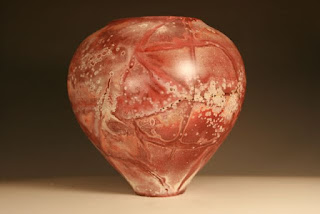 | |
| Photo by Mark McMillan, from the Ceramic Arts Daily Member Gallery |
"Concerns about ferric chloride come up enough times that I'm going to jump into this discussion as a former environmental chemist, with a number of years in the health and safety field.There were several comments, and some that stood out were by other potters who I highly respect for not only their knowledge but their willingness to share it! William S. had this to say in response:
Ferric chloride is used primarily in two different ways in raku. A solution of ferric chloride is sprayed on a hot pot to color the pot, as in ferric chloride fuming of horsehair raku pots. It (a solution) is also painted on bisque pots in the aluminum foil saggar process.
In terms of the toxicity I am going to focus on inhalation hazards, because it is doubtful that you will ingest it. And dermal toxicity is not as much a concern as inhalation toxicity (that is why you wear protective clothing and gloves).
Ferric chloride solutions are acidic. So when you directly inhale a sprayed solution of ferric chloride, the acid irritates and burns your tissues. This is why you start coughing and feel a burning sensation and your eyes sting.
When ferric chloride is heated above 500 degrees Fahrenheit, it decomposes to form hydrochloric acid and/or chlorine gas. If you are doing horsehair or a similar process, the pot is over 500 degrees F, so the fumes you inhale contain toxic hydrogen chloride (acidic) and toxic chlorine gas. In aluminum foil saggar, the temperatures in the kiln are well over 500 degrees F (1000 to 1300), so toxic fumes of hydrogen chloride and chlorine well be given off. This is why they don't recommend doing aluminum foil saggar in electric kilns, the elements and metal parts of the kiln get corroded.
So, HOW TO BE SAFE HANDLING FERRIC CHLORIDE? Don't get it on your skin - wear appropriate clothing and gloves. Wear an APPROPRIATE respirator. A paint mask will NOT protect you from fumes of hydrogen chloride and chlorine. You need a respirator with a cartridge good for particulates and acid gases (chlorine and hydrogen chloride). A particulate cartridge alone will not protect you. You can buy combo cartridges that are good for particulates, organic vapors, and acid gases. Make sure there are no spectators nearby or downwind when you spray.
Having said that, I know MANY potters who do not use respirators when working with ferric chloride. If you watch them you will notice that they always stand upwind when spraying, or use a spray booth. Brushing the ferric chloride solution on pots is not an inhalation problem, there are no fumes/mists/small droplets.
Do I follow my own advice? Most times, but I have to admit that sometimes I make a last minute decision to spray a pot with ferric chloride and don't run get my respirator with the appropriate cartridge. I try to be upwind when I spray and make sure that nobody else is around me. I'll still manage to inhale some and cough a little."
" I taught rake processes for years and one thing I always stressed about using ferric chloride was the need for common sense use. During any spraying process, most students did not have the proper respirator cartridges so I had a turntable set up away from the firing area, a small flag to indicate wind direction and a commercial grade portable fan blowing from behind and slightly to one side of the person spraying. FYI - if one uses a metal turntable, place a broken kiln shelf on top to protect the metal from the acidic action of the ferric chloride."
THANK YOU GENTLEMEN for you willingness to help educate those of us less knowledgeable!
As with anything, especially in ceramics, while the hazards may be scary or turn us away from possibly trying certain techniques; so long as proper safety protocols are followed and appropriate PPE (Personal Protective Equipment) is used, this technique can be executed safely. Remember to follow all safety guidelines and procedures, whether you agree with them or not. They are there for our safety. Another clay buddy, Harriet H., said it best:
"As we age, the damage to our bodies accumulates over time and takes a toll on our health. There are environmental factors such as pollution that we don't take into account and the effects are not felt until years down the road even if we only take occasional risks. If you don't take precautions for yourself, think of your loved ones and do it for them."I've included links to all applicable MSDS forms. Just click on the highlighted words to go view them. Or you can follow the links below:
FERRIC CHLORIDE MSDS
HYDROCHLORIC ACID MSDS
CHLORINE GAS MSDS
For more information on the techniques that use these chemicals, follow the links below.
Horse Hair Raku (Loveless Pottery has a GREAT post about the technique and if it's right for you)
Saggar Firing (Ceramic Arts Daily posted a very informative article on this, featuring the methods of Charlie and Linda Riggs)

No comments:
Post a Comment